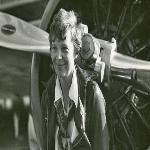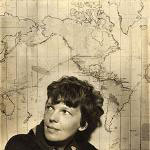
MARY TILLOTSON: This is Mary Tillotson.
STEVE EMBER: And this is Steve Ember with the VOA Special English program EXPLORATIONS. Today, we tell about Amelia Earhart. She was one of America's first female pilots.
(MUSIC)
MARY TILLOTSON: Amelia Earhart was born in 1897 in the middle western state of Kansas. She was not a child of her times. Most American girls at the beginning of the 20th century were taught to sit quietly and speak softly. They were not permitted to play ball or climb trees. Those activities were considered fun for boys. They were considered wrong for girls.
Amelia and her younger sister Muriel were lucky. Their parents believed all children needed physical activity to grow healthy and strong. So Amelia and Muriel were very active girls. They rode horses. They played baseball and basketball. They went fishing with their father. Other parents would not let their daughters play with Amelia and Muriel.
STEVE EMBER: The Earharts lived in a number of places in America's Middle West when the girls were growing up. The family was living in Chicago, Illinois when Amelia completed high school in 1916.
Amelia then prepared to enter a university. During a holiday, she visited her sister in Toronto, Canada. World War One had begun by then. And Amelia was shocked by the number of wounded soldiers sent home from the fighting in France. She decided she would be more useful as a nurse than as a student. So she joined the Red Cross.
MARY TILLOTSON: Amelia Earhart first became interested in flying while living in Toronto. She talked with many pilots who were treated at the soldiers' hospital. She also spent time watching planes at a nearby military airfield. Flying seemed exciting. But the machinery – the plane itself – was exciting, too.
After World War One ended, Amelia spent a year recovering from the disease pneumonia. She read poetry and went on long walks. She learned to play the banjo. And she went to school to learn about engines.
When she was healthy again, she entered Columbia University in New York City. She studied medicine. After a year she went to California to visit her parents. During that trip, she took her first ride in an airplane. And when the plane landed, Amelia Earhart had a new goal in life. She would learn to fly.
(MUSIC)
STEVE EMBER: One of the world's first female pilots, Neta Snook, taught Amelia to fly. It did not take long for Amelia to make her first flight by herself. She received her official pilot's license in 1920. Then she wanted a plane of her own. She earned most of the money to buy it by working for a telephone company. Her first plane had two sets of wings, a bi-plane.
On June 17th, 1928, the plane left the eastern province of Newfoundland, Canada. The pilot and engine expert were men. The passenger was Amelia Earhart. The plane landed in Wales 20 hours and 40 minutes later. For the first time, a woman had crossed the Atlantic Ocean by air.
MARY TILLOTSON: Amelia did not feel very important, because she had not flown the plane. Yet the public did not care. People on both sides of the Atlantic were excited by the tall brave girl with short hair and gray eyes. They organized parties and parades in her honor. Suddenly, she was famous.
Amelia Earhart had become the first lady of the air. She wrote a book about the flight. She made speeches about flying. And she continued to fly by herself across the United States and back.
STEVE EMBER: Flying was a new and exciting activity in the early 1920s. Pilots tested and demonstrated their skills in air shows. Amelia soon began taking part in these shows. She crashed one time in a field of cabbage plants. The accident did not stop her from flying. But she said it did decrease her desire to eat cabbages.
Flying was fun, but costly. Amelia could not continue. She sold her bi-plane, bought a car and left California. She moved across the country to the city of Boston, Massachusetts. She taught English to immigrants and then became a social worker.
MARY TILLOTSON: In the last years of the 1920s, hundreds of record flights were made. A few were made by women. But no woman had flown across the Atlantic Ocean.
A wealthy American woman, Amy Guest, bought a plane to do this. However, her family opposed the idea. So she looked for another woman to take her place. Friends proposed Amelia Earhart.
STEVE EMBER: American publisher George Putnam had helped organize the Atlantic Ocean flight that made Amelia famous. Afterwards, he continued to support her flying activities. In 1931, George and Amelia were married. He helped provide financial support for her record flights.
On May 20th, 1932, Amelia took off from Newfoundland. She headed east in a small red and gold plane. Amelia had problems with ice on the wings, fog from the ocean and instruments that failed. At one point, her plane dropped suddenly 900 meters. She regained control. And after 15 hours she landed in Ireland.
She had become the first woman to fly across the Atlantic Ocean alone.
(MUSIC)
MARY TILLOTSON: In the next few years, Amelia Earhart set more records and received more honors. She was the first to fly from Hawaii to California, alone. She was the first to fly from Mexico City to New York City, without stopping.
Amelia hoped her flights would prove that flying was safe for everyone. She hoped women would have jobs at every level of the industry when flying became a common form of transportation.
STEVE EMBER: In 1935, the president of Purdue University in Indiana asked Amelia to do some work there. He wanted her to be an adviser on aircraft design and navigation. He also wanted her to be a special adviser to female students.
Purdue University provided Amelia with a new all-metal, two-engine plane. It had so many instruments she called it the "Flying Laboratory." It was the best airplane in the world at that time.
Amelia decided to use this plane to fly around the world. She wanted to go around the equator. It was a distance of 43,000 kilometers. No one had attempted to fly that way before.
MARY TILLOTSON: Amelia's trip was planned carefully. The goal was not to set a speed record. The goal was to gather information. Crew members would study the effects of height and temperature on themselves and the plane. They would gather small amounts of air from the upper atmosphere. And they would examine the condition of airfields throughout the world.
Amelia knew the trip would be dangerous. A few days before she left, she gave a small American flag to her friend Jacqueline Cochran, another female pilot. Amelia had carried the flag on all her major flights. Jacqueline did not want to take it until Amelia returned from her flight around the world. "No," Amelia told her, "you had better take it now."
(MUSIC)
STEVE EMBER: Amelia and three male crew members were to make the flight. However, a minor accident and weather conditions forced a change in plans. So on June 1st, 1937, a silver Lockheed Electra plane left Miami, Florida. It carried pilot Amelia Earhart and just one male crew member, navigator Fred Noonan.

Amelia and Fred headed south toward the equator. They stopped in Puerto Rico, Surinam and Brazil. They crossed the Atlantic Ocean to Africa, where they stopped in Senegal, Chad, Sudan and Ethiopia. Then they continued on to India, Burma, Thailand, Singapore, Indonesia and Australia.
MARY TILLOTSON: When they reached New Guinea, they were about to begin the most difficult part of the trip. They would fly 4,000 kilometers to tiny Howland Island in the middle of the Pacific Ocean.
Three hours after leaving New Guinea, Amelia sent back a radio message. She said she was on a direct path to Howland Island. Later, Amelia's radio signals were received by a United States Coast Guard ship near the island. The messages began to warn of trouble. Fuel was getting low. They could not find Howland Island. They could not see any land at all.
STEVE EMBER: The radio signals got weaker and weaker. A message on the morning of July 2nd was incomplete. Then there was silence.
American Navy ships and planes searched the area for 15 days. They found nothing. Amelia Earhart and Fred Noonan were officially declared "lost at sea."
(MUSIC)
MARY TILLOTSON: This Special English Program was written by Marilyn Rice Christiano. It was produced by Catty Weaver. This is Mary Tillotson.
STEVE EMBER: And this is Steve Ember. Join us again next week for another EXPLORATIONS program on the VOICE OF AMERICA.
Art by Japanese-American detainees during World War Two shows their struggle and humanity
Guitar heroes, before anyone even heard of a video game
The sky is no limit for the tallest buildings in the world
(来源:VOA 编辑:陈丹妮)
